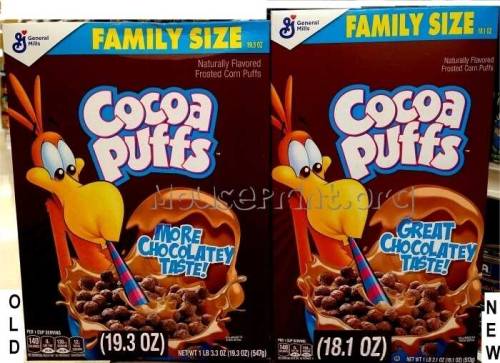The relentless inflation we are experiencing is forcing marketers to rethink everything. How do you respond to consumer discontent? Should they shrink from all the criticism? Do you suck it up and absorb your own price increases, yet keep your retail prices steady?
Or do you put on your thinking cap and get just a little bit sneaky?
Ahem, as it turns out, the trend is decidedly toward the latter. Marketers are shrinking packaging sizes to account for rising prices at all levels of the supply and manufacturing chain. It’s called shrinkflation, and it is going on at a grocery near you.

Variations Of The Shrinkflation Scheme
There are a couple of variations of this ploy, one involving shrinking the package and keeping the price the same, or shrinking the package and still raising the price at least a little bit. Either way, the customer gets less and winds up paying more compared to a year ago.
I noticed it the other day when perusing the pasta aisle. Never mind the shortages of some brands, which made it challenging enough to make a selection. But I noticed that one branded line had conveniently shrunk the package from 16 ounces to 12 ounces. The price was still 99 cents, though.
Notice That Difference?
Savvy marketers will lean on the notion of the JND, or Just Noticeable Difference. The thinking is that people will not notice small changes, and you can therefore make adjustments. But once you cross a certain threshold–which can and will vary by product category–then customers notice it. At this point, all bets are off as to what shoppers will do.
Smart shoppers will ignore, at least for the moment, the price, and instead look at the unit price. You can do this for liquid and dry measures, as well as countable items like tissues in a box. The smoke and mirrors of shrinkflation dissipate when countered with this sobering information.
Shrinkflation is also occurring in the service industry. Hotels have made noticeable differences in their offerings, starting with the lack of daily maid service and fewer toiletries, and continuing to the breakfast bar in the morning. Room rates may or may not have increased, but what guests get for their money has certainly dropped.
Categorical Defiance
There are a few product categories, though, in which there has not seen shrinkflation. We still buy milk by the gallon or quart, and canned sodas are still 12 or 16 ounces. Wines and liquors are regulated when it comes to sizing, although brewers have more freedom. This helps explain the arrival a few years ago of the popular “stovepipe” can, clocking in at a very odd 19.2 ounces instead of the more common 24 ounces. And a few years ago, when times were better, A-B InBev released all of its brews in 25-ounce cans, touting the free extra ounce as a come-on of epic drinking proportions.
But there is one other highly visible–and contentious–product that has also defied shrinkflation, and that is a gallon of gasoline. I paid $4.39 per gallon on 08 June 2022; the national average is $4.97. It seems like a natural for some other smaller measure, but when you consider that federal and state taxes are levied by the gallon, it would require conversion by the vendor when remitting their taxes.
Still, if stations priced it by the liter, people would be confused enough to never know what just hit them. For example, yesterday I Skyped my co-author and her husband in Germany. Naturally, we talked about gas prices, and they laughed at our perceived pain. My friends had just noticed a price of €2.10 for regular gasoline. This may sound ridiculously cheap compared to us, but they sell gas by the liter there. Once you convert measures and currencies into things that Americans readily understand, it comes out to US $8.49 a gallon!
Calm down, my friends. It could be a lot worse here. And this was after the German government relaxed the fuel tax by €0.35/liter, which is US $1.41 per gallon.
How To Survive Shrinkflation
The key for surviving inflation is for us all to become smarter shoppers. No, we cannot dodge the bullet forever, but we can shop more intelligently. We can trim discretionary things to allow for the essentials. We can pay attention to unit pricing. And we can purchase store brands instead of the nationals.
Finally, we can recognize that while it may seem like some marketers are trying to pull one over on us, they are facing the same pressures as consumers. There is no immunity card to be played at any level of the supply chain.
Just be careful to note the shrinking packages, because you may find yourself running out of breakfast cereal a little faster than before.
Dr. “Put This In Your Bowl And Think About It” Gerlich


